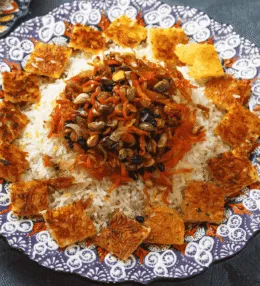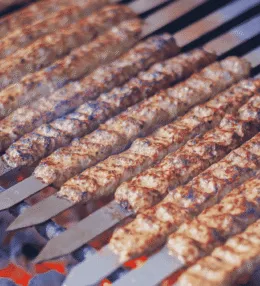
- View
Table of Contents
ToggleBolo de Caco is a rustic flatbread from Madeira that has earned a place on tables far beyond the island. Soft, slightly chewy, and infused with garlic butter, it is as comfortable alongside grilled meat as it is eaten alone, still warm from the griddle.
Its character lies in its balance. Simple in ingredients but rich in flavour, Bolo de Caco offers comfort and versatility. Locals eat it throughout the day, from breakfast with coffee to late night snacks after an evening out.
The bread is traditionally round and flat, with a lightly charred surface from being cooked on a hot stone or heavy griddle. It is this cooking method, along with its sweet potato base, that gives it a unique taste and texture.
Want to dive deeper into Portuguese Cuisine? Don’t miss our post on 38 Traditional Portuguese Foods to Try
What Is Bolo de Caco?
Bolo de Caco is a flatbread enriched with mashed sweet potato. The dough is shaped into rounds, then cooked directly on a hot slab or pan, creating a crust that is thin and lightly crisp while the inside stays soft.
It is almost always served warm, split open, and spread generously with garlic butter. This turns the bread into a dish in its own right rather than just an accompaniment, and it is often the first thing brought to the table in Madeira’s restaurants.
Beyond garlic butter, it can be filled with everything from grilled limpets to slices of chorizo. This adaptability is part of why it remains popular, whether eaten plain or turned into a hearty sandwich.
Ingredients and Taste
The base ingredients are flour, water, yeast, salt, and mashed sweet potato. The sweet potato gives a subtle sweetness and helps create a tender, moist crumb. This sets it apart from other flatbreads that can be dry if not eaten fresh.
The cooking method adds flavour. As the dough meets the hot surface, it develops faint char marks that bring a hint of smokiness. Inside, it stays fluffy and light, with the sweet potato lending both colour and softness.
Garlic butter is the classic partner. The richness of butter mixed with minced garlic and parsley melts into the warm bread, filling each bite with savoury depth. The combination of gentle sweetness and garlicky saltiness is what makes it irresistible.
A Taste of History
Bolo de Caco’s origins are tied to Madeira’s resourcefulness. The island’s volcanic soil is well suited for growing sweet potatoes and incorporating them into bread allowed bakers to stretch wheat flour, which was once more expensive.
The name comes from the traditional way it was cooked on a “caco”; a flat basalt stone heated over a fire. This method gave the bread its distinct texture and flavour, and even today many bakers still use it for authenticity.
As Madeira developed as a trading hub, Bolo de Caco became a symbol of its culinary identity. It was eaten by fishermen, farmers, and traders alike, serving as both a staple and a treat depending on the occasion.
Today, you can find it across Portugal and in Madeiran communities abroad, but the freshest experience remains on the island itself. Served hot, with garlic butter melting into its surface, it connects you instantly to the flavours and traditions of Madeira.
How to Make Bolo de Caco (Madeiran Flatbread)
Bolo de Caco is a soft, slightly sweet flatbread from Madeira traditionally cooked on a hot stone slab. It is light yet chewy, with the subtle flavour of sweet potato and a golden crust. Often enjoyed warm with garlic butter, it pairs beautifully with grilled meats, soups, or seafood. See the recipe card at the bottom for printable directions
Ingredients
For the dough
- 300g sweet potato, peeled and cut into chunks
- 500g strong bread flour
- 7g dried yeast
- 250ml lukewarm water (adjust as needed)
- 1 tsp salt
For serving
- 100g unsalted butter, softened
- 4 garlic cloves, finely chopped
- 2 tbsp fresh parsley, finely chopped
- Pinch of sea salt
Cooking Instructions
Step 1: Cook the sweet potatoes
To begin, boil the sweet potato chunks in lightly salted water until tender, around 15 minutes. Drain well, then mash until smooth. Allow to cool before mixing into the dough.
Step 2: Activate the yeast
In a small bowl, combine the dried yeast with lukewarm water and a pinch of sugar. Let it sit for 5–10 minutes until foamy, which indicates the yeast is active. Move to dough mixing.
Step 3: Combine dough ingredients
In a large mixing bowl, combine the bread flour and salt. Add the mashed sweet potato and yeast mixture. Mix until a rough dough forms, adding extra water if needed for a soft but not sticky texture. Proceed to kneading.
Step 4: Knead the dough
Turn the dough onto a floured surface and knead for 10 minutes until smooth and elastic. Kneading helps develop gluten for the bread’s signature chew. Transition to proofing.
Step 5: First proof
Place the dough into a lightly oiled bowl, cover with a damp cloth, and leave in a warm place for 1–1½ hours or until doubled in size. Move to shaping the flatbreads.
Step 6: Shape the flatbreads
Punch down the risen dough to release air. Divide into 4 equal pieces and shape each into a round disc about 2 cm thick. Dust lightly with flour to prevent sticking. Proceed to second proof.
Step 7: Second proof
Cover the discs with a clean cloth and allow them to rest for 20–30 minutes. This short proof helps achieve a light texture. Prepare the cooking surface next.
Step 8: Prepare the cooking surface
Traditionally cooked on a basalt stone, you can use a heavy cast iron skillet or griddle. Heat over medium to low until evenly hot. Transition to cooking the bread.
Step 9: Cook the flatbreads
Place each disc on the hot surface and cook for 4–5 minutes per side until golden brown spots appear and the bread is cooked through. Turn only once to keep the crust even. Move to final preparation.
Final Step: Serve with garlic butter
Mix softened butter with garlic, parsley, and sea salt. Slice the bread while still warm and spread generously. Serve immediately alongside grilled dishes or seafood.
Variations and substitutions
- Cooking surface substitution: Use a heavy non-stick pan if a cast iron skillet is not available.
- Sweet potato substitution: Butternut squash or pumpkin can be used for a slightly different sweetness.
- Flour substitution: All-purpose flour can be used, but bread flour gives a better chew.
Cooking Tips for Perfect Bolo de Caco
- Ensure the sweet potato is fully cooled before mixing to avoid killing the yeast.
- Maintain medium to low heat for even cooking without burning the crust.
- Do not skip the second proof, as it gives the bread its airy interior.
- Serve immediately for the best texture and flavour.

Bolo de Caco (Madeiran Flatbread)
Ingredients
For the dough
- 300 g sweet potato peeled and cut into chunks
- 500 g strong bread flour
- 7 g dried yeast
- 250 ml lukewarm water adjust as needed
- 1 tsp salt
For serving
- 100 g unsalted butter softened
- 4 garlic cloves finely chopped
- 2 tbsp fresh parsley finely chopped
- Pinch of sea salt
Instructions
- To begin, boil the sweet potato chunks in lightly salted water until tender, around 15 minutes. Drain well, then mash until smooth. Allow to cool before mixing into the dough.
- In a small bowl, combine the dried yeast with lukewarm water and a pinch of sugar. Let it sit for 5–10 minutes until foamy, which indicates the yeast is active. Move to dough mixing.
- In a large mixing bowl, combine the bread flour and salt. Add the mashed sweet potato and yeast mixture. Mix until a rough dough forms, adding extra water if needed for a soft but not sticky texture. Proceed to kneading.
- Turn the dough onto a floured surface and knead for 10 minutes until smooth and elastic. Kneading helps develop gluten for the bread’s signature chew. Transition to proofing.
- Place the dough into a lightly oiled bowl, cover with a damp cloth, and leave in a warm place for 1–1½ hours or until doubled in size. Move to shaping the flatbreads.
- Punch down the risen dough to release air. Divide into 4 equal pieces and shape each into a round disc about 2 cm thick. Dust lightly with flour to prevent sticking. Proceed to second proof.
- Cover the discs with a clean cloth and allow them to rest for 20–30 minutes. This short proof helps achieve a light texture. Prepare the cooking surface next.
- Traditionally cooked on a basalt stone, you can use a heavy cast iron skillet or griddle. Heat over medium to low until evenly hot. Transition to cooking the bread.
- Place each disc on the hot surface and cook for 4–5 minutes per side until golden brown spots appear and the bread is cooked through. Turn only once to keep the crust even. Move to final preparation.
- Mix softened butter with garlic, parsley, and sea salt. Slice the bread while still warm and spread generously. Serve immediately alongside grilled dishes or seafood.
Nutrition
You May Also Like







Leave a Review